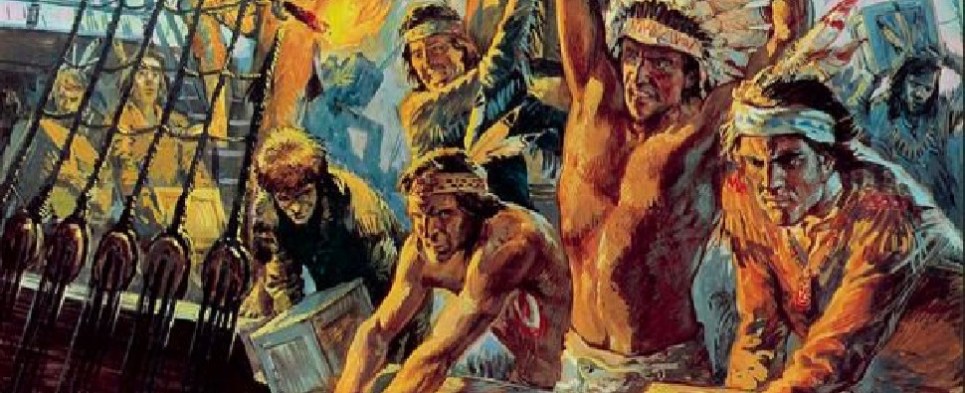HOW WE REACT TO UNFAIR TRADE, 1773-2018 EDITION
No butts in line! How many times did you hear that in kindergarten? Point being that Americans learn the concept of fairness at an early age. When faced with unfair trade practices, we react—as we did at the Boston Tea Party, and how United States Trade Representative Robert Lighthizer is reacting to NAFTA’s outdated automotive rules of origin. Under current NAFTA rules, at least 62.5 percent of the net cost of a passenger car or light truck must originate in the U.S., Canada or Mexico to avoid tariffs. Lighthizer wants the threshold raised to 85 percent and half the content made here. Since the U.S. absorbs the vast majority of new car sales from Mexican manufactured autos, this seems quite reasonable. We’re already dealing with a 62.5 percent quota within the context of a free trade agreement. This implies that upwards of 37.5 percent of auto parts could be originating from outside Canada, the U.S. or Mexico and thereby piggybacking off our free trade agreement. It’s certainly free for the interloping countries, but it sure ain’t a free deal for us. It gets back to the first rule of kindergarten: no butts in line.
Remember Mickey Kantor? He was President Clinton’s USTR and also served as Secretary of Commerce. I recently ran into him at an event hosted by the Los Angeles County Economic Development team and the LA World Trade Center. At 80, he is sharp as a whip and full of spunk. “NAFTA has been good for all three countries. We’ve lost 7 million manufacturing jobs since 1980 but have gained 33 million other jobs. We are doing quite well. Just listen to your president as he waxes eloquent about how strong our economy is. Well, I guess NAFTA hasn’t killed it.” OK … but now a reality check. The U.S. population in 1980 was 226 million. Today, it is 324 million, an increase of 98 million. So, a net gain of 26 million jobs versus a population gain of 98 million is not all that stellar. It begs the question: How many more manufacturing jobs would there be without NAFTA? All I’m saying is that when job stats are attributed to NAFTA, we have to ask is that because of NAFTA or in spite of it? Ambassador Kantor went on to share that he most definitely agrees that NAFTA needs to be re-worked (“That was eons ago”) and that trade has to be fair and conducted on a level playing field. In essence, three things right out of Bob Lighthizer’s playbook, which just goes to show you that trade is one area where Republicans and Democrats can come together.
President Trump’s State of the Union Address was a 10. Whether you are a business owner or an employee working in the private sector, how could you give it any grade except an A+? Economic development agencies are going to get busy fast showing domestic and foreign corporations available plots of land upon which to build. As for young Mr. Kennedy’s rebuttal? He gets a C-. While the delivery was “Kennedy-esque,” the substance was weak. They were the same old tired lines we have heard from Nancy Pelosi for too long, with no facts to back them up.
Did you catch the news that China’s economy grew by 6.9 percent in 2017? He won’t say so, but President Trump just raised his own bar for where he wants to take U.S. growth. If China can post 6.9 percent growth, Trump will shoot for 7 percent. Preposterous, you say? It happened once before in 1984. I wouldn’t bet against it. We are just now getting glimpses of what the corporate tax cut will mean. The economic benefits from so many companies announcing new economic expansion in the U.S., and raises for workers, will take a few years to show up in actual statistics. And we are just seeing the tip of the iceberg for now. When the lower half of the S&P 500 companies kick their investment into gear to keep pace with their larger cap brethren, it will set off a chain reaction of growth that will rival post WWII expansion. Following suit will be thousands of SMEs and when that happens, we could indeed see GDP growth at China’s level. And the Dems said that the tax cuts unfairly favored “big corporations?” They really do need to find a story to tell.
Speaking of China, interesting poll results from the American Chamber of Commerce in China show that although three out of four companies say they feel less welcome in China than before, nonetheless by the same margin companies anticipate increasing their investments there in 2018. Of course, the survey was taken before the Trump tax cut was passed. So, let’s see if those companies are still eating from the same rice bowl as the year unfolds.
It’s hard not to notice the ads being placed by Pratt Industries Chairman Anthony Pratt in the Wall Street Journal touting Team Trump’s accomplishments while at the same time advocating to “export food, not jobs” and reminding us that this administration has cut 22 regulations for every new one. Dilly dilly.
Remember the dinner conversation from my last column?
A reader writes:
And here we go again–another attempt to claim that there is a unique “cultural” component to counterfeiting in China. After two decades fighting fakes in both the U.S. and China (as well as dozens of other countries), I can definitively state that it just isn’t true.
Most counterfeits are currently produced in China not because of a different cultural approach to concepts of ownership, but because most of EVERYTHING is currently made in China. For a variety of reasons, it is where people go to get products produced. So, it is no surprise that it is also where people go to get counterfeit products produced. After all, if all things were made on the moon, then the counterfeits would be made on the moon as well!
Consider Peter Baldwin’s book The Copyright Wars: Three Centuries of Trans-Atlantic Battle. In it, he documents how America was the major source of copyright theft from the dominant power of the time, England, from its founding until well into the 1800s. This had nothing to do with any imaginary cultural weakness in the American people. Rather, it was simple economic reality. And if we are asking the question about why counterfeits are mainly produced in China, we have to ask the question why counterfeits are mainly consumed in America and Western Europe. The answer in both cases is not some theoretical cultural bias, but nothing more than the fact that some economic actors are always willing to break the rules if it will make them more profit. Those bad actors do not represent some basic cultural truth about the society from which they come–they only represent that every society produces a subset of economic criminals.
William Mansfield, Director of Intellectual Property, ABRO Industries, Inc.





Leave a Reply